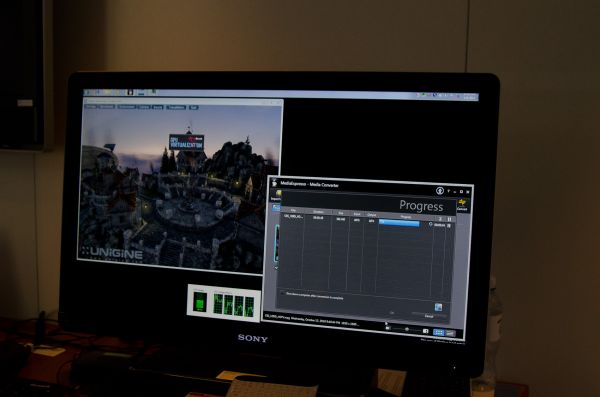Lucid Enables Quick Sync with Discrete Graphics on Sandy Bridge
by Anand Lal Shimpi on January 7, 2011 5:24 AM EST- Posted in
- CPUs
- Intel
- Sandy Bridge
- Lucid
If you read our Sandy Bridge Review you’ll know that we were very excited about Intel’s Quick Sync hardware transcode engine. It easily offers at least twice the performance of existing GPU based transcoding solutions without sacrificing image quality. There’s just one little problem: you can’t use Quick Sync you're using a discrete GPU, you need to use Intel's processor graphics.
Lucid presented a potential solution to the problem at this year’s CES. Through software alone, Lucid is able to copy the frame buffer from a discrete PCIe GPU to the frame buffer of SNB’s HD Graphics in main memory. The result is that you can hook a single monitor up to your motherboard’s video output and use a discrete GPU when you want it. Lucid’s technology would enable switchable graphics on the desktop, without any hardware requirements (it still obviously won’t work on P67, shame on Intel).
To demonstrate the technology Intel ran an H67 motherboard with a GeForce GTX 480. Lucid’s software was installed which allowed for the GTX 480 to run and its frame buffer output to be copied to main memory and sent out via Intel’s Flexible Display Interface through the DVI port on the back of the motherboard.
At the same time, Intel demonstrated that it could run a Quick Sync enabled transcode in Cyberlink’s Media Espresso 6 - all thanks to Lucid’s software.
Lucid expects that there will only be a 1 - 3% impact in performance (although that’s something we’d have to see for ourselves), but there’s no firm date on when the driver will be available. I’m expecting a beta version of Lucid’s software in the coming weeks however.
Motherboard manufacturers could bundle Lucid’s solution with their boards to avoid upsetting end users thanks to Intel’s Quick Sync oversight. There’s still no getting around the fact that you can’t overclock your CPU on H67 motherboards. You’ll still have to wait for Z68 to fix that problem.











44 Comments
View All Comments
marc1000 - Friday, January 7, 2011 - link
i second your opinion... LOLzodiacfml - Friday, January 7, 2011 - link
useless, really. there's more information in Anandtech articles.soydeedo - Friday, January 7, 2011 - link
Yeah, I felt bad for the guy.MrSpadge - Saturday, January 8, 2011 - link
Agreed. After reading Anands SNB review I thought "I could have done better than the Intel guy". Well, thanks for trying anyway :)MrS
Robert Kooijman - Friday, January 7, 2011 - link
From my humble experience, "marketing" staff often lack tech knowledge beyond the surface of power-point slides.Those who do, are "shielded" from the outside.
I'm sure Anand is familiar with this, but there's not an awful lot he can do about it.
Anyway, I would like to thank Anand and staff for writing articles of such high caliber. I'm truly impressed with what you guys are doing!
DesktopMan - Friday, January 7, 2011 - link
It makes no sense. Sure you can't use the integrated graphics output as P67 doesn't have support for the motherboard DVI/HDMI connectors, but if Quick Sync runs on the CPU why wouldn't you be able to use it? Seems like it still goes through the graphics drivers and thus is disabled if you use a discrete GPU. Did they not want to add new instructions for the encoding/decoding as they did with AES-NI? Maybe there's no space for them...If my guess on how this works is correct the Lucid solution should also work on P67, unless the GPU and the video encode/decode circuits are permanently shut down on P67 with no way to turn them on again.
Basically anyone doing video editing can't use a discrete graphics card until this solution is in place, otherwise they can't use Quick Sync. If you also do 3d modeling or gaming that seems like a really bad design decision on Intel's part.
This might even mess up laptops with discrete graphics that do not have the Lucid solution, unless the mobile chipsets do allow the encoders and decoders to be running in such a case.
goozira - Friday, January 7, 2011 - link
I don't think you have to worry about laptops, since they already have switchable graphics solutions. The only problem might be an Intel Chipset with an AMD graphics card.On the post earlier, I wasn't knocking the guy for not knowing. If I remember right, he is lead engineer of the Sandy Bridge project. I was just wondering why he gave a definite "no" on switchable graphics for desktops. In my opinion, switchable graphics on a desktop (especially with the new Quick Sync technology) is a huge selling point. I guess the real question I was asking is how close does Intel work with 3rd parties when designing their hardware?
yvizel - Friday, January 7, 2011 - link
He cannot be a lead engineer of the Sandy Bridge project since it was designed in the Israeli site.softdrinkviking - Friday, January 7, 2011 - link
I thought quick sync was part of the igp area of the SNB chip and that's why it won't work without the igp enabled. That's what I took the article here on anandtech to mean anyway.DesktopMan - Friday, January 7, 2011 - link
Yep. But why do you have to turn the IGP off? Just leave it on for encoding / decoding work without using it for any display. I don't see why that would require a third party software pack, unless Intel just doesn't care.